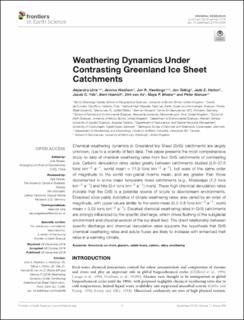| dc.contributor.author | Urra, Alexandra | |
| dc.contributor.author | Wadham, Jemma L. | |
| dc.contributor.author | Hawkings, Jon R. | |
| dc.contributor.author | Telling, Jon | |
| dc.contributor.author | Hatton, Jade E. | |
| dc.contributor.author | Yde, Jacob C. | |
| dc.contributor.author | Hasholt, Bent | |
| dc.contributor.author | van As, Dirk | |
| dc.contributor.author | Bhatia, Maya P. | |
| dc.contributor.author | Nienow, Peter W. | |
| dc.coverage.spatial | Greenland | en_US |
| dc.date.accessioned | 2020-03-26T10:36:17Z | |
| dc.date.available | 2020-03-26T10:36:17Z | |
| dc.date.created | 2020-01-14T08:21:39Z | |
| dc.date.issued | 2019 | |
| dc.identifier.citation | Urra, A., Wadham, J., Hawkings, J. R., Telling, J., Hatton, J. E., Yde, J. C., . . . Nienow, P. (2019). Weathering dynamics under contrasting greenland ice sheet catchments. Frontiers in Earth Science, 7. | en_US |
| dc.identifier.issn | 2296-6463 | |
| dc.identifier.uri | https://hdl.handle.net/11250/2648836 | |
| dc.description.abstract | Chemical weathering dynamics in Greenland Ice Sheet (GrIS) catchments are largely unknown, due to a scarcity of field data. This paper presents the most comprehensive study to date of chemical weathering rates from four GrIS catchments of contrasting size. Cationic denudation rates varied greatly between catchments studied (2.6–37.6 tons km–2 a–1, world mean = 11.9 tons km–2 a–1), but were of the same order of magnitude to the world non-glacial riverine mean, and are greater than those documented in some major temperate rivers catchments (e.g., Mississippi (1.3 tons km–2 a–1) and Nile (0.4 tons km–2 a–1) rivers). These high chemical denudation rates indicate that the GrIS is a potential source of solute to downstream environments. Dissolved silica yields, indicative of silicate weathering rates, also varied by an order of magnitude, with upper values similar to the world mean (0.2–3.8 tons km–2 a–1, world mean = 3.53 tons km–2 a–1). Elevated chemical weathering rates in GrIS catchments are strongly influenced by the specific discharge, which drives flushing of the subglacial environment and physical erosion of the ice sheet bed. The direct relationship between specific discharge and chemical denudation rates supports the hypothesis that GrIS chemical weathering rates and solute fluxes are likely to increase with enhanced melt rates in a warming climate. | en_US |
| dc.language.iso | eng | en_US |
| dc.publisher | Frontiers Media S.A. | en_US |
| dc.rights | Navngivelse 4.0 Internasjonal | * |
| dc.rights.uri | http://creativecommons.org/licenses/by/4.0/deed.no | * |
| dc.subject | ice sheet | en_US |
| dc.subject | glaciers | en_US |
| dc.subject | solute fluxes | en_US |
| dc.subject | cations | en_US |
| dc.subject | silica | en_US |
| dc.subject | weathering | en_US |
| dc.title | Weathering Dynamics Under Contrasting Greenland Ice Sheet Catchments | en_US |
| dc.type | Peer reviewed | en_US |
| dc.type | Journal article | en_US |
| dc.description.version | publishedVersion | en_US |
| dc.rights.holder | Copyright © 2019 Urra, Wadham, Hawkings, Telling, Hatton, Yde, Hasholt, van As, Bhatia and Nienow. | en_US |
| dc.source.pagenumber | 15 | en_US |
| dc.source.volume | 7 | en_US |
| dc.source.journal | Frontiers in Earth Science | en_US |
| dc.identifier.doi | 10.3389/feart.2019.00299 | |
| dc.identifier.cristin | 1771949 | |
| cristin.ispublished | true | |
| cristin.fulltext | original | |
| cristin.qualitycode | 1 | |

